Our recommendations are made independently. We may receive commissions from purchases made via our links.
How to Reheat Mashed Potatoes
Mashed potatoes are a fan-favourite everywhere. Learn how to reheat mashed potatoes and make another serving out of your leftover in this guide.
Mashed potatoes are a classic recipe that can suit just about any occasion from intimate dinners to Thanksgiving. But since the dish is very filling, it’s not rare to have leftovers after a meal, so it won’t be a waste of time to try and learn how to reheat mashed potatoes properly. You will eventually need the skill.
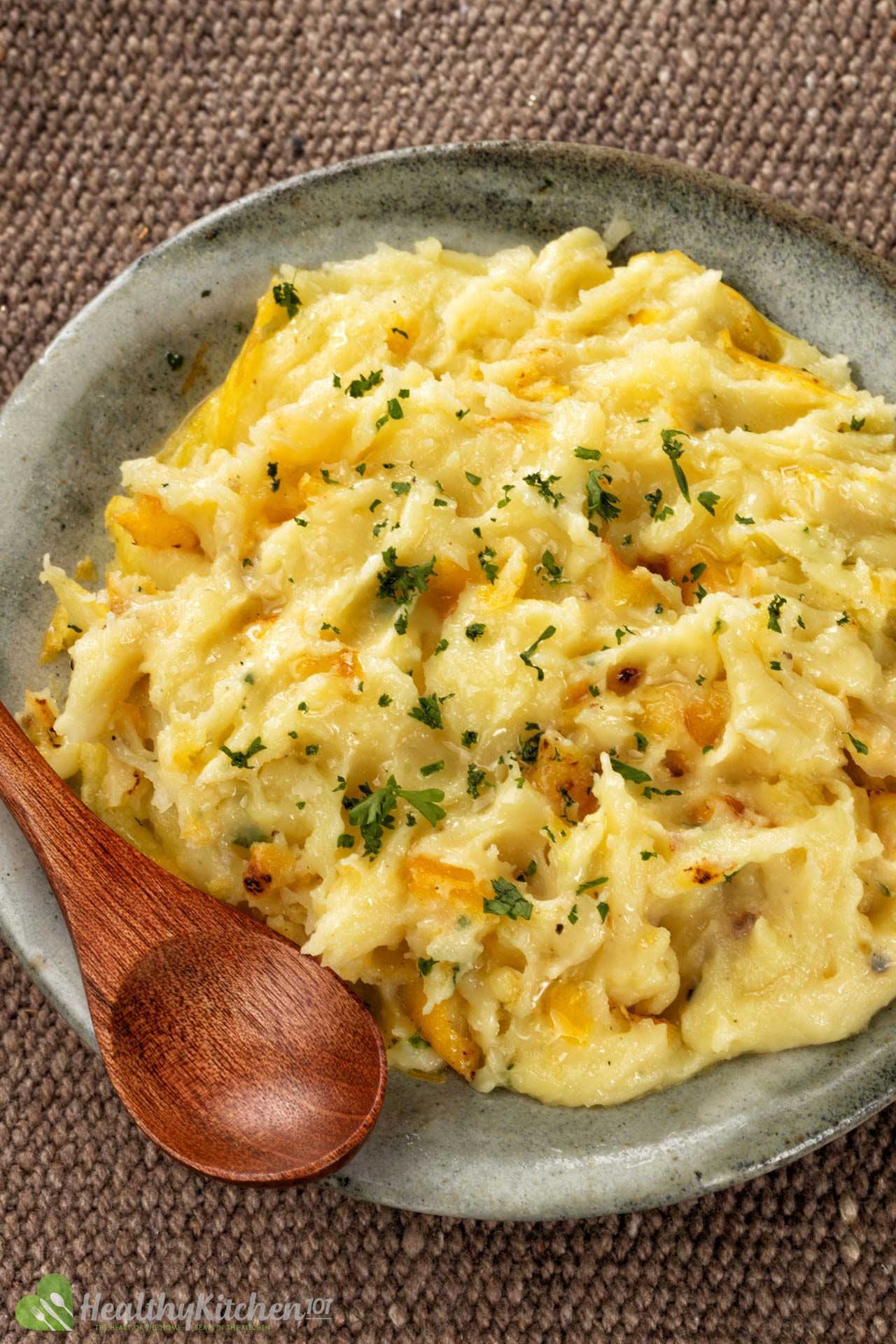
The Best Ways to Reheat Mashed Potatoes
Fortunately, mashed potatoes are a very easy dish to handle. There are many tricks that you can use to restore the cold mash to the creaminess and richness that it had before you threw it into the fridge.
The best ways to reheat mashed potatoes are to use the oven, the stovetop, or a slow cooker (a Crock Pot).
Another viable method (though we do not recommend unless you’re very stuck and have no other options) is to reheat using the microwave. Though it is convenient and quick, microwaves are infamous for their ability to suck the moisture from out of food. As a result, microwaved mashed potatoes would turn out very dry and all-around unappealing rather than having the desired consistency and texture.
1. How to Reheat Mashed Potatoes In Oven
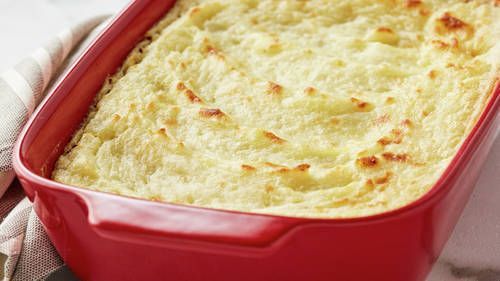
For a lot of people, taking advantage of the low temperature and slow cooking speed of the oven is the best way to rewarm a container of mashed potatoes. Though this method takes longer, it can preserve best the moisture and natural taste of the mash.
Place the cold mash into a baking dish. Use a spoon or a spatula to spread the potatoes out evenly across the whole dish. The more even it is, the quicker it can heat and the less moisture is lost.
The trick to reheating in the oven comes in the form of two extras: butter and milk. The butter fattens up the potatoes and makes it creamier, while the milk brings extra moisture. Add a bit of both to the mix to bring out the flavors.
Cover up the baking dish with aluminum foil and put it into the oven. Cook at 325°F for about 30 minutes. Occasionally, open the oven and stir the potatoes to ensure that it’s cooked evenly all throughout. You can add more milk or butter to the mix if needed, too.
One interesting extra: you can reheat lasagna in virtually the same manner as described above. If you have a container of leftover lasagna in the fridge, take the opportunity and prepare it, too. It goes really well with the creamy mashed potatoes.
Such is the versatility of the oven that you can even use it to broil food. In fact, broiling in the oven is also one of the many different ways to reheat corn on the cob. It’s yet another food that can be perfectly taken together with mashed potatoes.
2. In Crock Pot
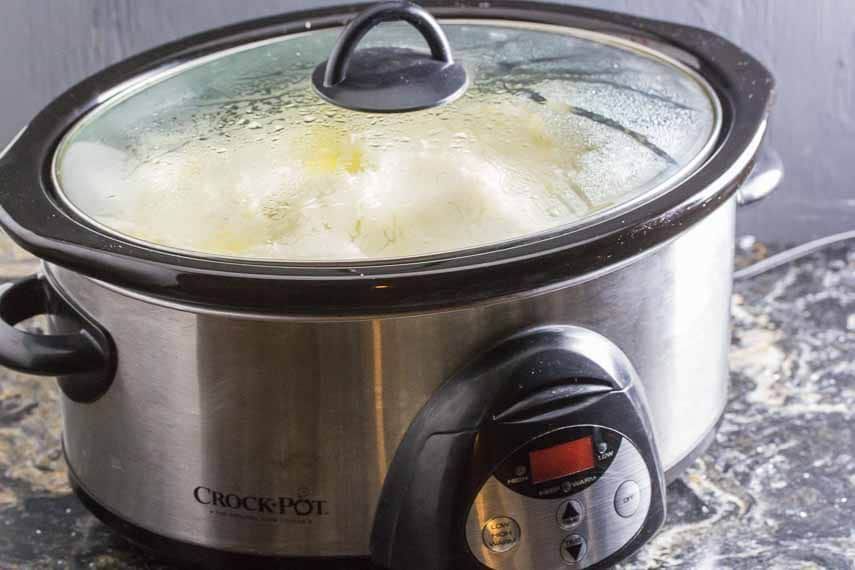
If you have a slow cooker like a Crock Pot at home, it opens up a very convenient way to reheat your mashed potatoes. By pressing a few buttons, a Crock Pot can automatically reheat and keep the reheated mashed potatoes warm until you need to serve them.
Bring the cold mashed potatoes from out of the fridge approximately four or three ½ hours before serving time. Place it into the pot, then add some milk and cream into the pot to keep the potatoes hydrated.
Set the cooking heat to Low and the machine will handle the rest for you. Over the course of three hours, remember to open up the Crock Pot to stir the potatoes a few times. By serving time, it will have become piping hot and ready to be placed on a platter.
3. On the Stove
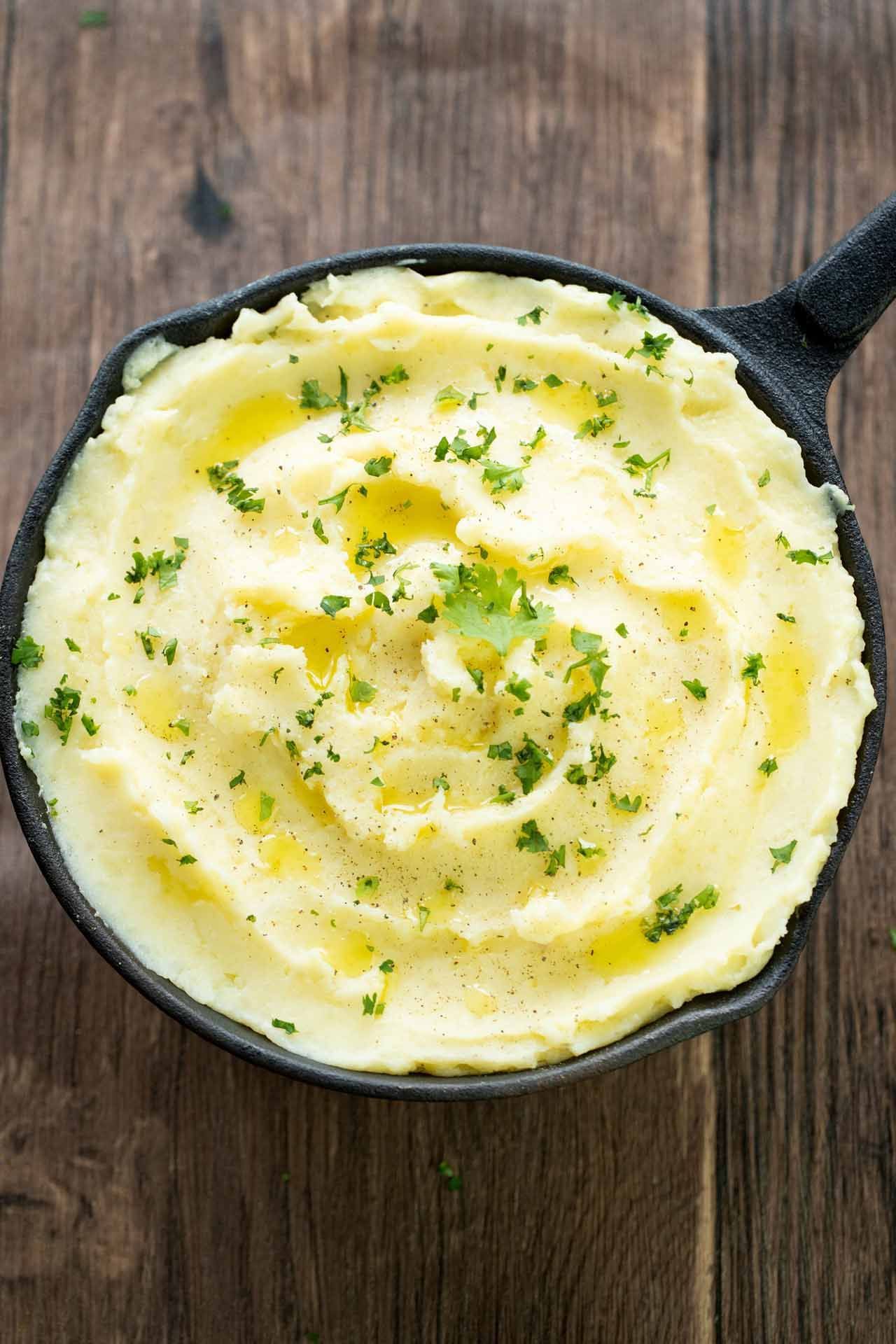
If you don’t have an oven you can use, you can substitute it for a stove and a skillet. Both methods take about the same amount of time (30 minutes) and the basics are nearly identical.
Put your cold mashed potatoes into a mixing bowl and mix it up with a dash of milk or cream.
Take out a skillet (make sure that it’s non-stick) and place it over medium-low heat. Use it to melt about two tbsps of butter. If you have a lot of potatoes to reheat, you can put in one or two extra tbsps.
When the butter starts bubbling, put the cold mashed potatoes into the skillet immediately. You shouldn’t wait until the butter turns brown or the potatoes would get a strange nutty taste (some people actually prefer it this way, so you can try it out if you want.)
Cook over medium-low heat for roughly 30 minutes or until the temperature is decent (you can use a thermometer for this.) Stir the mashed potatoes frequently to make sure that it won’t burn or stick to the bottom of the skillet.
4. In the Microwave
If you absolutely must use a microwave to reheat your mashed potatoes, put it into a microwave-safe bowl. As always, add some milk and butter into the mix to keep the potatoes moist and creamy.
Wrap up the bowl with saran wrap and set up the microwave for half power (50%). Power up the microwave and let the potatoes warm up for 60 seconds. Take the bowl out, stir, taste, and test the temperature. Continue warming up the potatoes in 60-second bursts for as long as it is necessary.
You should be careful not to overdo it, lest the potatoes dry out or be burnt.
Other potato-based recipes, such as french fries can also be reheated using the microwave. It’s not the most optimal way to reheat fries, but it sure works.
And before you grow to resent your microwave, it’s not always the worst option to reheat food. As an example, it is one of the best ways to reheat rice safely. So, you shouldn’t be afraid of using the microwave from time to time, especially when you’re short on time.
5. How to Reheat Frozen Mashed Potatoes
You can approach frozen mashed potatoes in many ways. The least fussy way is to take the frozen mash out of the freezer and let it thaw the night before you plan to eat it.
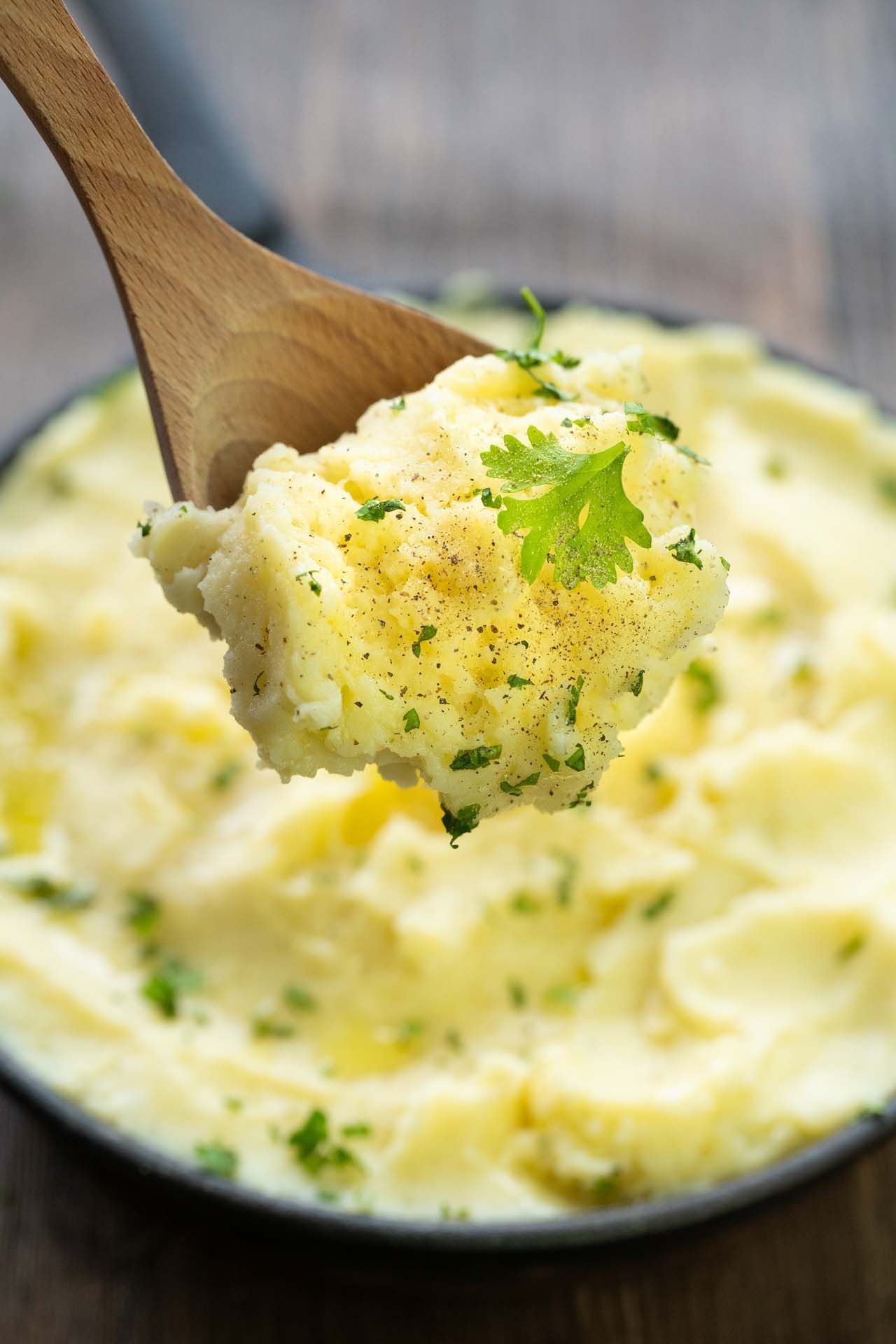
But let’s assume that you need to cook frozen mashed potatoes immediately from straight out the freezer. You can use all four of the previously mentioned methods with a few small tweaks.
- With an oven: Reheat it as you normally would. Place it into a baking dish along with some milk and butter, then cover it up with aluminum foil. Because frozen mashed potatoes also need time to thaw, it will usually need to spend more than 30 minutes inside of the oven before it reaches an acceptable temperature.
- With a Crock Pot (slow cooker): The night before you set to cook it, move the mash from the freezer to the fridge for it to thaw. About three hours before serving time, take it out from the fridge, put it into the cooker, and set the power on Low. Stir the pot occasionally.
- With a stove: Over low heat, warm up the frozen potatoes in a lidded saucepan. Stirs as needed to keep the heating even until the potatoes are adequately warm. If the potatoes start to dry out, you can add milk or butter to rehydrate.
- With a microwave: Place the frozen mash on a microwave-safe plate or in a bowl. Cover everything up with saran wrap and heat the potatoes at 50% power for about 5 minutes. Watch the mashed potatoes throughout the whole process to ensure that it isn’t burnt.
Conclusion
Mashed potatoes are a wonderful recipe to enjoy regardless of the occasion, so if it isn’t to reduce food wastage, making a second helping out of the leftovers is well worth learning how to reheat mashed potatoes.
Interested in learning how to reheat other kinds of food that you think you may one day find in your fridge? We have some other reheating guides for you to browse through:
- How to Reheat Fried Chicken: mashed potatoes are a popular side dish for fried chicken. So, if you have a drumstick or a wing leftover in the fridge, it’s time to bring them out. You can reheat them side-by-side with your mashed potatoes using this guide.
- How to Reheat Steak: steak and mashed potatoes is yet another classic combo. Drizzled with gravy, mashed potatoes is a top-notch companion to a piece of steak. The starch will also make your meal more fulfilling and wholesome. Try out one of the reheating methods outlined here. They can reheat your steak with minimal loss in quality.
- How to Reheat Prime Rib Roast: prime rib — like its name suggests — often has very high quality. Therefore, you should always try to salvage it through reheating if you cannot finish it up in a single sitting. Fortunately, if you follow the exact instructions here, you’ll be able to without breaking too much sweat.
- Can You Reheat Rotisserie Chicken? — Best Reheating Methods: rotisserie chicken is the go-to recipe for many family’s dinners. It’s quite simple to make and is doubtlessly tasty. The leftovers can be shortly dealt with using one of the few methods here. You may even be able to make an entire extra meal out of reheated rotisserie chicken!
- Tips on Reheating Crab Legs: smooth, sweet, and buttery, crab legs are a favorite of seafood lovers everywhere. But you probably feel a bit anxious about reheating seafood. Unlike meat, many kinds of seafood usually aren’t reheatable. The good news is that crab legs can be reheated (with a few caveats). Check this out if you’re interested!
- How to Reheat Chicken Wings in an Air Fryer: chicken wings can pair up with mashed potatoes very well just like fried chicken. We found that among the best ways to reheat chicken wings is to use an air fryer. Compared to other methods, the chicken wings not only cook quicker, but are also crispier and tastier, as well. Find out more details in this guide.
- How to Reheat Salmon in an Air Fryer: like crab legs, reheating salmon can be an anxiety-inducing experience. Fortunately, salmon can be reheated fairly safely. As long as you store it correctly prior to reheating and carefully check for signs of spoilage, it can be perfectly reheated. One of the best ways to do that is through an air fryer, which you can learn in this reheating guide.





